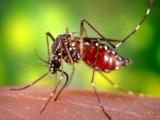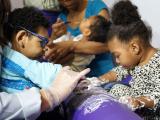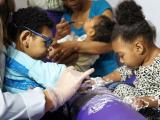Today the Centers for Disease Control and Prevention (CDC) reported the first known case of female-to-male sexual transmission of Zika virus, in a couple from New York City.
The case was discovered after a routine investigation by the New York City (NYC) Department of Health and Mental Hygiene (DOHMH), and a detailed account of their illnesses was published today in Morbidity and Mortality Weekly Report (MMWR). The CDC said the case will change its sexual transmission guidelines for the virus.
"The CDC will be updating soon the existing recommendations to address potential women-to-partner transmission," the CDC's John Brooks, MD, said in an interview.
"That includes women with female sexual partners, pregnant or not. Zika will be treated like any other STI [sexually transmitted infection], and we will be recommending barrier protection or abstinence."
Brooks is a medical epidemiologist in the CDC's Division of HIV/AIDS Prevention.
Single act of unprotected sex
According to the report, a woman in her 20s who wasn't pregnant traveled to a country with ongoing Zika transmission. The day she returned to New York she had a single act of condomless vaginal intercourse with her male partner, also in his 20s.
The next day she developed several symptoms, including fever, fatigue, rash, swelling of the extremities, and tingling in her hands and feet. Three days later she visited her primary care physician, who took blood and urine samples, which were both positive for Zika virus.
Seven days after the act of intercourse, the woman's partner began experiencing symptoms, including fever, joint pain, and rash. Three days after the onset of his symptoms, he went to the same physician, who suspected sexual transmission of Zika. Zika virus was detected in the man's urine sample but was not found in serum testing.
During extensive interviewing with the DOHMH, officials established that the man had not traveled to any region where Zika is active, had not had mosquito bites, and described the same single sex act. The man also reported no blood on his penis, no oral or anal sex, and no other sexual partners. The man was uncircumcised, and it's assumed he was infected from either vaginal secretions or the woman's menstrual blood. (The woman began menstruating shortly after intercourse.)
"This case and a recent study of vaginal secretions in rhesus monkeys with Zika show us that female-to-partner transmission is likely," said Brooks. He also mentioned a Jul 11 letter published in The Lancet that described Zika virus in a woman's cervical mucus.
Until this week, the CDC had reported 14 cases of sexually transmitted Zika virus in the United States, all male-to-female or male-to-male transmission. At least 11 other countries have reported sexually transmitted Zika, but none have described female-to-partner transmission.
Brooks said the CDC is now conducting a study in Puerto Rico that measures the Zika viral load in different bodily fluids and secretions in both men and women.
"This is an avoidable disease, and most cases will cause mild illness without serious side effects," Brooks said. "That being said, the thing we [CDC officials] need now is people to report any possible sexual transmission of Zika virus. That gives us the best chance of understanding the virus and helping pregnant couples."
Expert: Pattern matches other flaviviruses
Irina Burd, MD, Ph.D., associate professor of gynecology and obstetrics at Johns Hopkins University School of Medicine, said she was not surprised the CDC reported a case of female-to-male transmission.
"I've expected that Zika could behave like other viruses in the Flaviviridae family of viruses," said Burd. She mentioned hepatitis C and bovine virus diarrhea (BVD) as two diseases to watch when trying to understand Zika. Even though neither is mosquito-borne, they both feature vertical transmission between mother and fetus.
Burd said the sexual transmission patterns seen in Zika look like hepatitis C, while the neurologic birth defects are similar to those seen in BVD.
"Right now what we're learning about Zika changes day to day," said Burd. "I would urge researchers to go to other viruses in this family to learn what to expect."
PAHO reports more microcephaly cases
In other Zika news, the Pan American Health Organization (PAHO) published its weekly Zika report today, noting increasing numbers of cases in Mexico and the Caribbean. To date, 40 countries in the Americas have reported Zika virus, with 5 countries (Canada, the United States, Argentina, Chile, and Peru) reporting sexual transmission
The PAHO said 11 countries, including Brazil, Jamaica, and Venezuela, are reporting an increase in Guillain-Barre syndrome (GBS). Four countries in the Caribbean, (Dominica, Grenada, and St. Vincent and the Grenadines) reported suspected GBS cases linked to Zika.
Colombia is now reporting 5 more confirmed cases of microcephaly linked to Zika virus, bringing the country's total to 18 confirmed cases (112 suspected). Brazil reported 31 more cases of microcephaly to bring its total to 1,687 cases.
Mosquito control, sequencing, handling specimens
- Dengue infections dropped by 91% compared with the previous year in a district of the Brazilian city of Piracicaba where genetically modified mosquitoes were released, Oxitec, the company that engineered the mosquitoes and conducted the trial, announced yesterday. According to the city's surveillance data, 12 dengue cases were reported during the 2015-2016 period, compared with 133 the previous year. Also, no chikungunya or Zika illnesses were reported. The trial took place in the city's Eldorado district, which was a dengue hot spot the season before the mosquitoes were released. Officials said the city as a whole saw a drop in dengue activity, due to a combination of mosquito control activities. Oxitec said the next phase of the trial will include downtown Piracicaba, a city of about 367,000 people in Sao Paulo state.
- Sequencing of 11 full and partial Zika genomes isolated last year from patients infected in the Brazilian city of Salvador, in its hardest-hit state of Bahia, suggests a distinct lineage in the area with sustained circulation since the middle of 2014. A team from Brazil and the University of California San Francisco reported their findings yesterday in Emerging Infectious Diseases. The lineage was closely related to a sequence from Maranhao state, with the analysis also suggesting another possible introduction from Para state—findings that suggest the virus in that area of Bahia came from other parts of Brazil rather than from outside the country. All are in northeastern Brazil. The researchers said the timing is consistent with first-trimester infections and reported microcephaly.
- The European Centre for Disease Prevention and Control today issued a guide on how to safely handle human substances potentially containing Zika virus. The information ties in with earlier similar guidance on West Nile virus and blood safety and incorporates what's currently known about Zika infection in humans. It covers whole blood and components, plasma, sperm, tissues and other cell materials, and organs.
CIDRAP news editor Lisa Schnirring contributed the bulleted summaries.
See also
Jul 11 Lancet letter
Jul 15 PAHO report





















